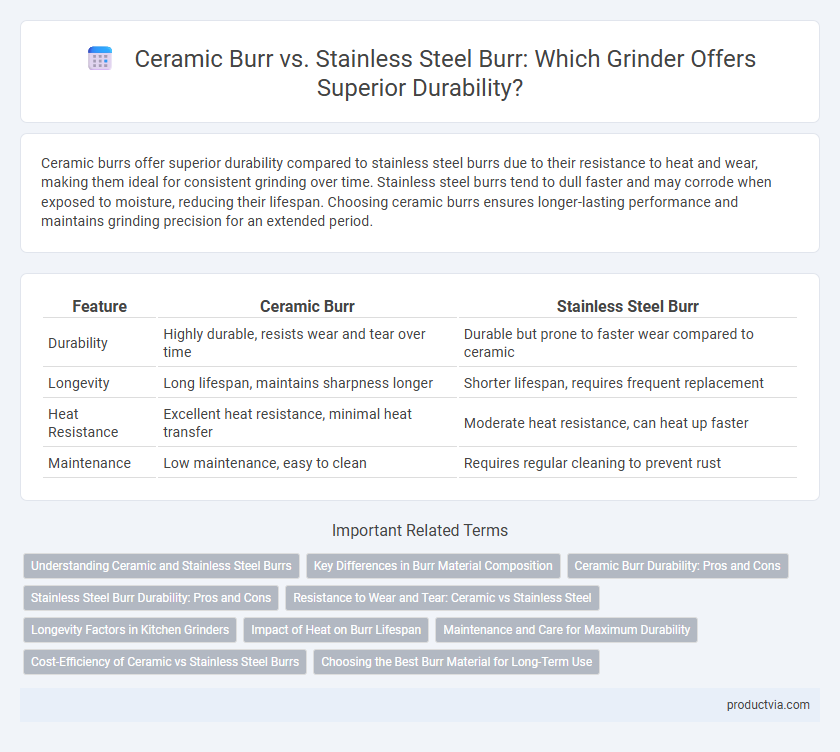Ceramic burrs offer superior durability compared to stainless steel burrs due to their resistance to heat and wear, making them ideal for consistent grinding over time. Stainless steel burrs tend to dull faster and may corrode when exposed to moisture, reducing their lifespan. Choosing ceramic burrs ensures longer-lasting performance and maintains grinding precision for an extended period.
Table of Comparison
| Feature | Ceramic Burr | Stainless Steel Burr |
|---|---|---|
| Durability | Highly durable, resists wear and tear over time | Durable but prone to faster wear compared to ceramic |
| Longevity | Long lifespan, maintains sharpness longer | Shorter lifespan, requires frequent replacement |
| Heat Resistance | Excellent heat resistance, minimal heat transfer | Moderate heat resistance, can heat up faster |
| Maintenance | Low maintenance, easy to clean | Requires regular cleaning to prevent rust |
Understanding Ceramic and Stainless Steel Burrs
Ceramic burrs excel in durability due to their hardness and resistance to wear, maintaining sharpness longer and producing a consistent grind over time. Stainless steel burrs, while slightly less hard, offer greater toughness and impact resistance, reducing the risk of chipping or breaking under heavy use. Both materials provide reliable performance, but ceramic burrs are favored for precision longevity, whereas stainless steel burrs suit environments demanding robust handling.
Key Differences in Burr Material Composition
Ceramic burrs are made from tough, wear-resistant ceramic compounds that maintain sharpness longer and resist heat buildup during grinding, enhancing durability for prolonged use. Stainless steel burrs consist of high-grade metal alloys that offer excellent impact resistance and strength but tend to dull faster due to metal fatigue and heat exposure. The key difference in burr material composition lies in ceramic's superior hardness and thermal stability compared to stainless steel's toughness and shock resistance, influencing longevity and grinding consistency.
Ceramic Burr Durability: Pros and Cons
Ceramic burrs offer exceptional durability due to their hardness and resistance to wear, maintaining sharpness longer than stainless steel burrs under regular grinding conditions. They are less prone to corrosion and heat damage, which can prolong the lifespan of the grinder, but they are more brittle and susceptible to chipping or cracking if exposed to hard foreign objects. The choice of ceramic burrs enhances grinder longevity for frequent coffee enthusiasts, though careful handling is required to avoid breakage.
Stainless Steel Burr Durability: Pros and Cons
Stainless steel burrs offer exceptional durability due to their resistance to chipping and wear, making them ideal for long-term use in grinders. They maintain sharpness over extended periods but may require occasional sharpening to ensure peak performance. Compared to ceramic burrs, stainless steel burrs handle tougher beans better but could dull faster under extreme conditions.
Resistance to Wear and Tear: Ceramic vs Stainless Steel
Ceramic burrs exhibit superior resistance to wear and tear due to their hardness and ability to maintain sharp edges longer than stainless steel burrs, making them ideal for consistent grinding performance over extended use. Stainless steel burrs, while more prone to dulling and abrasion, offer greater toughness against impacts and potential chipping, providing durability in environments where mechanical stress is a factor. The choice between ceramic and stainless steel burrs depends largely on the grinder's usage intensity and the balance between edge retention and impact resistance needed.
Longevity Factors in Kitchen Grinders
Ceramic burrs exhibit superior longevity due to their exceptional hardness and resistance to wear, maintaining sharpness longer than stainless steel burrs in kitchen grinders. Stainless steel burrs may corrode or dull more quickly under frequent use, especially when exposed to moisture or acidic substances. Choosing ceramic burrs enhances grinder durability by ensuring consistent performance and reducing the need for frequent replacements.
Impact of Heat on Burr Lifespan
Ceramic burrs exhibit superior heat resistance compared to stainless steel burrs, maintaining sharpness and structural integrity under prolonged grinding sessions. Stainless steel burrs tend to heat up faster, accelerating wear and reducing overall lifespan due to metal fatigue and potential warping. The minimal heat absorption of ceramic burrs ensures consistent grinding performance and extended durability in high-demand grinding environments.
Maintenance and Care for Maximum Durability
Ceramic burrs are highly resistant to wear and corrosion, requiring minimal maintenance to maintain optimal grinding performance over time. Stainless steel burrs demand regular cleaning to prevent rust and buildup, ensuring consistent durability and efficiency. Proper care, including routine inspection and timely replacement, is essential for both materials to maximize the lifespan of grinder burrs.
Cost-Efficiency of Ceramic vs Stainless Steel Burrs
Ceramic burrs offer superior durability due to their resistance to wear and corrosion, extending their lifespan significantly compared to stainless steel burrs. While ceramic burrs generally have a higher upfront cost, their long-term cost-efficiency is favorable as they require less frequent replacement and maintain consistent grinding performance over time. Stainless steel burrs, though initially cheaper, tend to dull faster and may incur higher maintenance or replacement costs, impacting overall cost-effectiveness in commercial or heavy-use settings.
Choosing the Best Burr Material for Long-Term Use
Ceramic burrs offer exceptional hardness and resistance to wear, making them highly durable for long-term grinding without significant dulling. Stainless steel burrs provide durability with greater impact resistance and are less prone to chipping, suitable for heavy-duty use but may wear faster than ceramic over extended periods. Choosing between ceramic and stainless steel burrs depends on balancing hardness and toughness according to grinding frequency and material hardness for optimal long-term performance.
Ceramic burr vs Stainless steel burr for durability Infographic

 productvia.com
productvia.com